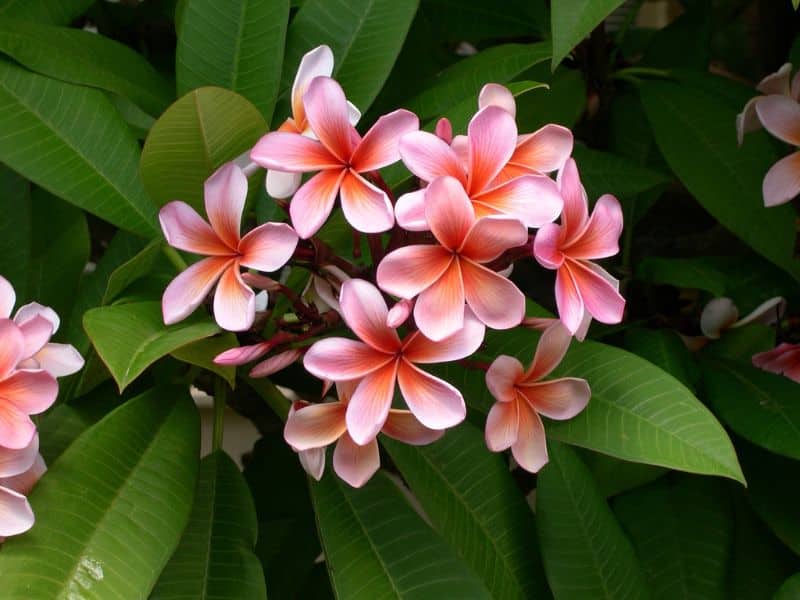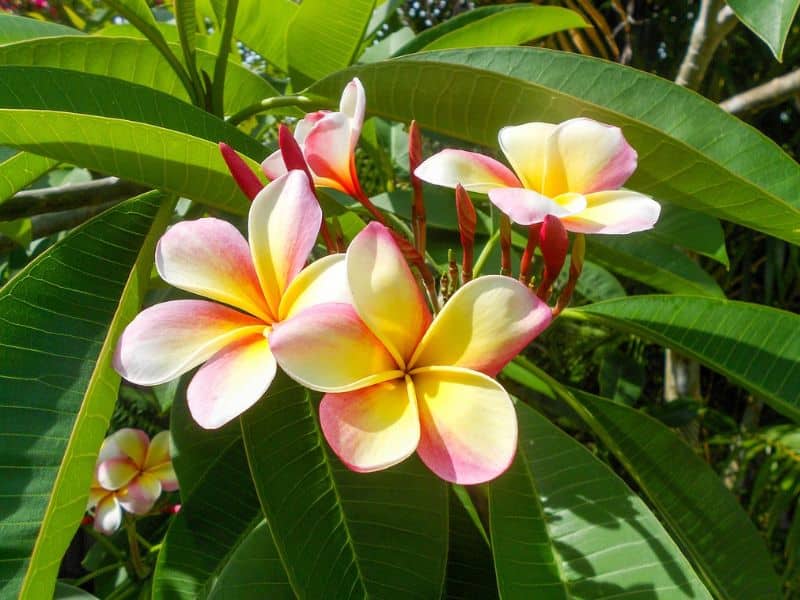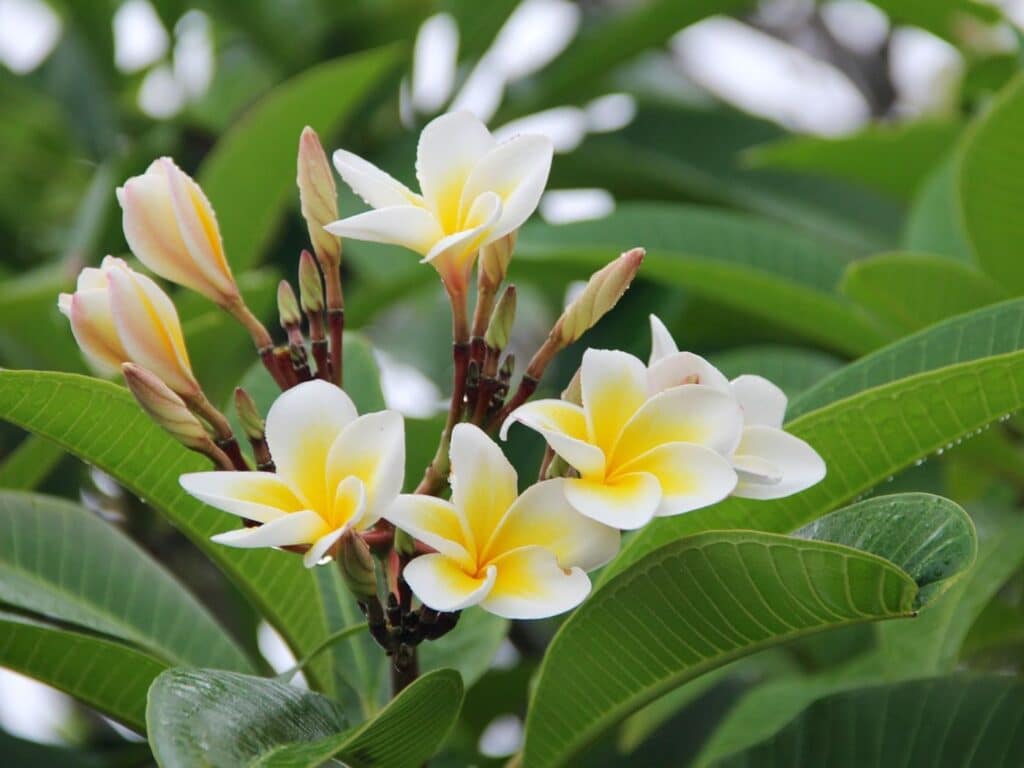Imagine stepping into a garden, greeted by the enchanting fragrance and vibrant hues of Plumeria flowers. These tropical beauties, often associated with Hawaiian leis, can transform your garden into a paradise.
However, growing Plumeria may well seem daunting if you’re unfamiliar with their care. Fear not, as mastering the art of nurturing these exotic flowers is within your reach.
This article is your gateway to understanding how to care for Plumeria, ensuring they flourish and brighten your garden. From selecting the perfect spot for planting to the intricacies of watering, fertilizing, and pruning, we’ll guide you through each step. Embrace the journey of growing Plumeria, and let’s turn your garden into a fragrant oasis together.
Understanding Plumeria Varieties and Their Origins

The Enchanting Fragrance of Plumeria Flowers
The scent of Plumeria flowers captures the essence of a tropical paradise. Each variety boasts its own distinctive aroma, ranging from sweet to spicy. This fragrance plays a key role in the plant’s appeal, making Plumerias a favorite for gardens and floral arrangements alike.
Beyond their beauty, the scent of Plumeria flowers has been shown to have a calming effect, offering a slice of tranquility right in your backyard.
Plumeria’s Presence in Different Cultures
Plumeria varieties hold a special place in various cultures around the globe, symbolizing everything from immortality to love and friendship. In Hawaiian culture, they’re often used in lei-making, serving as a warm welcome to visitors.
In Southeast Asian countries, such as Thailand and Indonesia, Plumerias are associated with temples and are used in religious ceremonies. The plant’s widespread significance is not just a testament to its beauty but also to its ability to adapt to different environments, making it a beloved flower across continents.
Essential Conditions for Growing Plumeria
Cultivating Plumeria requires attention to certain core conditions, laying the foundation for these tropical beauties to thrive. From understanding their sunlight and temperature preferences to ensuring the soil composition is just right, mastering these basics will transform your garden into a fragrant paradise.
Sunlight and Temperature Requirements
Plumeria flowers are sun worshippers, craving at least six hours of direct sunlight each day. Think of them as your garden’s sunbathers, luxuriating in the warmth to produce those vibrant colors and intoxicating scents. But, they’re not fans of the cold.
Temperatures below 50°F (10°C) could send them into a dormant state, and a frost could be fatal. If you live in a cooler climate, consider growing Plumeria in pots that can be moved indoors when the thermometer dips.
The Ideal Soil Composition
When it comes to soil, Plumeria has a type. They pine for well-draining, slightly acidic to neutral soil with a pH between 6.0 and 7.0. Achieving this perfect mix may well seem like you’re brewing a potion, but it’s simpler than it sounds.
Incorporate plenty of perlite or sand into your garden soil to improve drainage and prevent root rot, Plumeria’s arch-nemesis. Remember, they prefer to stay on the dry side, akin to a cactus, embracing drought over dampness any day.
By addressing these essential conditions, you’ll have a head start in your quest to grow flourishing Plumeria plants that bring a touch of the tropics to your garden or home.
Planting Plumeria: Starting Your Plumeria Journey

Propagation Techniques for Plumeria
Starting your Plumeria garden begins with the right approach to propagation. You have a couple of choices here: seeds and cuttings. Planting seeds may well be a bit of a gamble since they can grow into plants with unexpected flower colors, which adds a bit of mystery to the process.
Conversely, cuttings guarantee the same characteristics as the parent plant, making them a reliable choice if you’re aiming for consistency in your garden. Remember, patience is key with both methods, as Plumeria takes its sweet time to bloom.
Tips for Planting Plumeria Cuttings
When diving into planting Plumeria cuttings, think of it as a delicate art form rather than a rigorous science project. First off, select a cutting from a healthy plant, ideally measuring about 12 to 18 inches in length.
Give it some time to dry and callous over for about a week before you plant it, which helps avoid rot. Your cuttings prefer a warm, sunny spot and well-draining soil to flourish.
Stick the cutting about 4 inches deep into the soil and refrain from watering it until you see new growth, which typically signals that it has rooted properly. This method isn’t just about growing a flower; it’s about starting a journey with a living piece of art that requires care, understanding, and a sprinkle of love.
By following these insights, you’re not only ensuring the successful start of your Plumeria growing adventure but also setting the stage for a vibrant, fragrant oasis that could very well turn into the highlight of your garden. Keep these tips in mind, exercise a little patience, and soon, you’ll have Plumeria flowers that make every visitor stop and stare.
Caring for Your Plumeria Plants
Watering Routines for Optimal Growth
Plumerias thrive on a balance, not too wet, not too dry. Aiming your hose just right, give them a good soak once a week during the summer. In cooler months, ease up and let the rain handle some of the work, watering only when the soil feels dry to the touch about an inch deep.
Overwatering can spell disaster for these tropical treasures, leading to root rot, so think of it as treating them to a refreshing drink rather than a flood.
The Right Way to Fertilize Plumeria
This is where you get to play chemist. Plumerias hunger for high-phosphorus fertilizer to boost their blooming potential. Applying a 10-30-10 blend every two to three weeks during the growing season feeds this need perfectly. But, as fall approaches, taper off to let your plant ease into dormancy with grace.
Remember, this isn’t just about feeding; it’s about timing, too. Giving them a nutrient-rich diet at the right time encourages dazzling blooms that are a feast for the eyes.
Pruning Plumeria for Better Blooms
Think of pruning your Plumeria as giving it a spa day. A trim here or there in the spring not only tidies up any unruly branches but also encourages more generous flowering. Snipping off any dead or damaged parts keeps the plant healthy and looking sharp. But don’t go overboard; a light touch is all it takes.
A well-pruned Plumeria is a happy Plumeria, ready to reward you with an abundance of fragrant flowers. Remember, pruning isn’t about taking away; it’s about creating space for more beauty to emerge.
Troubleshooting Common Plumeria Problems
Plumeria plants are known for their vibrant flowers and sweet fragrance, making them a popular choice for gardeners seeking to add a tropical flair to their space. However, like all plants, they can encounter issues. By understanding common problems and how to address them, you can keep your Plumeria thriving.
Pests and Diseases to Watch Out For
Spider mites and mealybugs are the usual suspects when it comes to Plumeria pests. These tiny nuisances can sap the life out of your plant, leaving the leaves looking dull and undernourished. If you notice leaves turning yellow, it’s a sign that your plumeria may be struggling due to these pests.
A simple solution is to spray the plant with a mild soap solution or neem oil, focusing on the undersides of the leaves where these pests love to hide. Fungal diseases, like rust, can also appear, characterized by orange spots on the leaves. Prompt removal of affected leaves and avoiding overhead watering can help prevent its spread.
Weather-Related Plumeria Concerns
Plumeria loves the sun but can struggle when temperatures soar too high or dip too low. In extreme heat, ensure your plant gets a bit of afternoon shade and stays well-hydrated. Conversely, Plumeria plants are not fond of cold weather.
If temperatures threaten to drop below 50°F, it’s time to bring your potted Plumeria indoors or protect outdoor plants with frost cloths. This simple shift in care can prevent cold damage to your tropical beauty.
Dealing with Root Rot and Nutrient Deficiencies
Overwatering is a common mistake that can lead to root rot, a serious condition for Plumeria plants. If the plant looks wilted but the soil is wet, you may well be dealing with root rot. Scale back on watering and consider repotting the plant in fresh, well-draining soil.
Nutrient deficiencies, particularly a lack of phosphorus, can inhibit flower production and lead to lackluster growth. Boosting your feeding routine with a high-phosphorus fertilizer will encourage vibrant blooms and healthy development.
By keeping an eye out for these issues and adjusting care practices accordingly, you can enjoy the lush, fragrant beauty of Plumeria flowers for seasons to come. Remember, proactive care is key to preventing and solving most garden problems, and Plumeria plants are no exception.
Enhancing Plumeria Growth: Extra Tips and Tricks

Encouraging Plumeria Blooms
To get your Plumeria flaunting those envy-inducing blooms, consider boosting them with a phosphorus-rich fertilizer. These fertilizers encourage flowering, giving your plants just the kick they need to start producing vibrant blooms.
Apply this special blend early in the spring and follow up with regular applications according to the product’s instructions. Remember, more blooms start with what you feed your plant, so choosing the right Plumeria fertilizer makes all the difference.
Sunlight is another critical factor; Plumeria thrives under full sun. Make sure these tropical beauties get at least six hours of direct sunlight daily. If your plants are indoors or in a shaded area, consider relocating them to a sunnier spot. This move will not only maximize their bloom potential but also enhance the vividness of their colors.
Seasonal Care Variances
Seasonal changes demand a shift in your Plumeria care routine. During the warmer months, your focus should be on regular watering and fertilization to support their growth phase. However, as the cooler weather rolls in, it’s time to dial back.
Reduce watering to prevent waterlogging the soil, which can be detrimental during colder temperatures. Likewise, halt fertilization to allow your plants to enter a natural dormancy period.
In regions where temperatures drop significantly, consider bringing your Plumeria indoors or providing a protective cover to shield them from frost. If you’re growing Plumeria in pots, moving them inside offers an added layer of control over their environment, ensuring they stay warm and cozy until spring returns. Adjusting your care regimen with the seasons not only supports their health but also sets the stage for a stunning display when blooming season comes around again.
Frequently Asked Questions
What are Plumeria flowers?
Plumeria flowers are tropical plants known for their vibrant colors and intoxicating fragrance. They play a significant role in various cultures and are often used in lei-making in Hawaii.
How do I care for Plumeria plants?
Caring for Plumeria involves selecting a sunny location, regular watering, fertilizing with high-phosphorus blends, and pruning for better blooms. It’s crucial to adjust care based on the plant’s growth stage and seasonal changes.
What is the ideal watering routine for Plumeria?
Water Plumeria deeply but infrequently, allowing the soil to dry slightly between waterings. Reduce watering frequency during cooler months to prevent root rot.
How often should I fertilize Plumeria plants?
Fertilize Plumeria every 2-3 weeks during the growing season with a high-phosphorus fertilizer to encourage blooming. Reduce fertilization in the cooler months.
Why is pruning important for Plumeria?
Pruning encourages stronger branches that can support more flowers and improves air circulation around the plant, reducing the risk of disease. It also helps maintain the desired shape and size of the plant.
How can I protect my Plumeria from pests and diseases?
Regularly inspect plants for signs of pests and diseases, such as spider mites, mealybugs, and rust. Use appropriate organic or chemical treatments as needed. Good cultural practices, like proper watering and airflow, are key to prevention.
What should I do if my Plumeria has root rot?
If root rot occurs, often due to overwatering, remove the affected plant from its pot, trim away the rotten roots, and repot in fresh, well-draining soil. Ensure proper watering practices going forward.
Can Plumeria flowers grow in cold climates?
Plumeria can grow in colder climates with care. Provide protection from frost or bring potted plants indoors during winter. Adjust watering and fertilizing schedules to accommodate cooler temperatures and reduced sunlight.
How does seasonal change affect Plumeria care?
Seasonal changes require adjustments in Plumeria care, mainly in watering and fertilizing routines. During cooler months, reduce both to prevent stress on the plant. Protection from frost is vital in cold climates.
What fertilizers are best for enhancing Plumeria growth?
Use fertilizers rich in phosphorus to promote blooming. Balanced blends are also good for overall health, but the emphasis on phosphorus helps with flower production. Always follow package instructions for best results.
Learn more about Plumeria’s flower symbolism to see why people love this plant!







